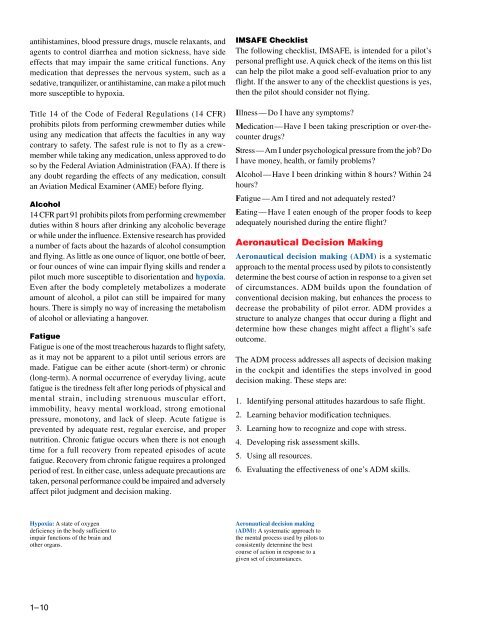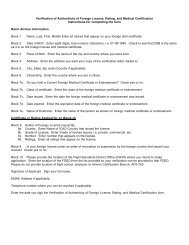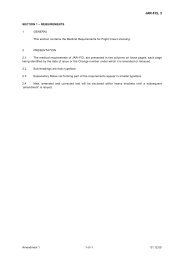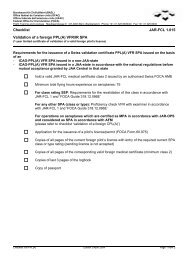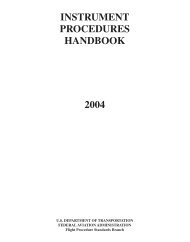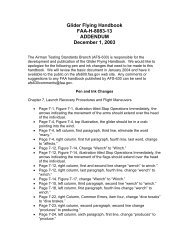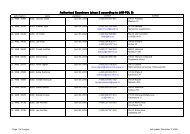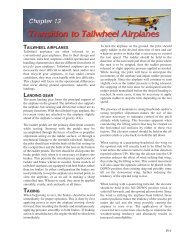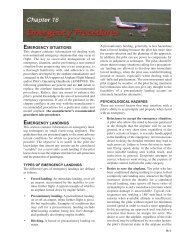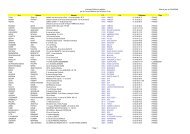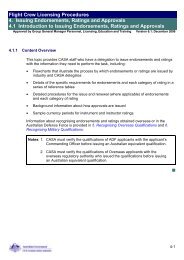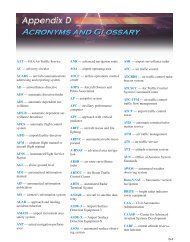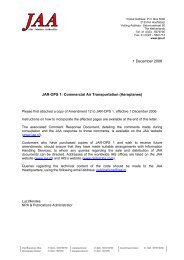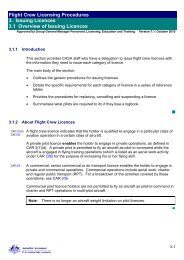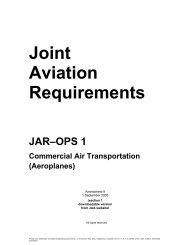FAA-H-8083-15, Instrument Flying Handbook -- 1 of 2 - US-PPL
FAA-H-8083-15, Instrument Flying Handbook -- 1 of 2 - US-PPL
FAA-H-8083-15, Instrument Flying Handbook -- 1 of 2 - US-PPL
Create successful ePaper yourself
Turn your PDF publications into a flip-book with our unique Google optimized e-Paper software.
antihistamines, blood pressure drugs, muscle relaxants, andagents to control diarrhea and motion sickness, have sideeffects that may impair the same critical functions. Anymedication that depresses the nervous system, such as asedative, tranquilizer, or antihistamine, can make a pilot muchmore susceptible to hypoxia.Title 14 <strong>of</strong> the Code <strong>of</strong> Federal Regulations (14 CFR)prohibits pilots from performing crewmember duties whileusing any medication that affects the faculties in any waycontrary to safety. The safest rule is not to fly as a crewmemberwhile taking any medication, unless approved to doso by the Federal Aviation Administration (<strong>FAA</strong>). If there isany doubt regarding the effects <strong>of</strong> any medication, consultan Aviation Medical Examiner (AME) before flying.Alcohol14 CFR part 91 prohibits pilots from performing crewmemberduties within 8 hours after drinking any alcoholic beverageor while under the influence. Extensive research has provideda number <strong>of</strong> facts about the hazards <strong>of</strong> alcohol consumptionand flying. As little as one ounce <strong>of</strong> liquor, one bottle <strong>of</strong> beer,or four ounces <strong>of</strong> wine can impair flying skills and render apilot much more susceptible to disorientation and hypoxia.Even after the body completely metabolizes a moderateamount <strong>of</strong> alcohol, a pilot can still be impaired for manyhours. There is simply no way <strong>of</strong> increasing the metabolism<strong>of</strong> alcohol or alleviating a hangover.FatigueFatigue is one <strong>of</strong> the most treacherous hazards to flight safety,as it may not be apparent to a pilot until serious errors aremade. Fatigue can be either acute (short-term) or chronic(long-term). A normal occurrence <strong>of</strong> everyday living, acutefatigue is the tiredness felt after long periods <strong>of</strong> physical andmental strain, including strenuous muscular effort,immobility, heavy mental workload, strong emotionalpressure, monotony, and lack <strong>of</strong> sleep. Acute fatigue isprevented by adequate rest, regular exercise, and propernutrition. Chronic fatigue occurs when there is not enoughtime for a full recovery from repeated episodes <strong>of</strong> acutefatigue. Recovery from chronic fatigue requires a prolongedperiod <strong>of</strong> rest. In either case, unless adequate precautions aretaken, personal performance could be impaired and adverselyaffect pilot judgment and decision making.IMSAFE ChecklistThe following checklist, IMSAFE, is intended for a pilot’spersonal preflight use. A quick check <strong>of</strong> the items on this listcan help the pilot make a good self-evaluation prior to anyflight. If the answer to any <strong>of</strong> the checklist questions is yes,then the pilot should consider not flying.Illness—Do I have any symptoms?Medication—Have I been taking prescription or over-thecounterdrugs?Stress—Am I under psychological pressure from the job? DoI have money, health, or family problems?Alcohol—Have I been drinking within 8 hours? Within 24hours?Fatigue—Am I tired and not adequately rested?Eating—Have I eaten enough <strong>of</strong> the proper foods to keepadequately nourished during the entire flight?Aeronautical Decision MakingAeronautical decision making (ADM) is a systematicapproach to the mental process used by pilots to consistentlydetermine the best course <strong>of</strong> action in response to a given set<strong>of</strong> circumstances. ADM builds upon the foundation <strong>of</strong>conventional decision making, but enhances the process todecrease the probability <strong>of</strong> pilot error. ADM provides astructure to analyze changes that occur during a flight anddetermine how these changes might affect a flight’s safeoutcome.The ADM process addresses all aspects <strong>of</strong> decision makingin the cockpit and identifies the steps involved in gooddecision making. These steps are:1. Identifying personal attitudes hazardous to safe flight.2. Learning behavior modification techniques.3. Learning how to recognize and cope with stress.4. Developing risk assessment skills.5. Using all resources.6. Evaluating the effectiveness <strong>of</strong> one’s ADM skills.Hypoxia: A state <strong>of</strong> oxygendeficiency in the body sufficient toimpair functions <strong>of</strong> the brain andother organs.Aeronautical decision making(ADM): A systematic approach tothe mental process used by pilots toconsistently determine the bestcourse <strong>of</strong> action in response to agiven set <strong>of</strong> circumstances.1–10


